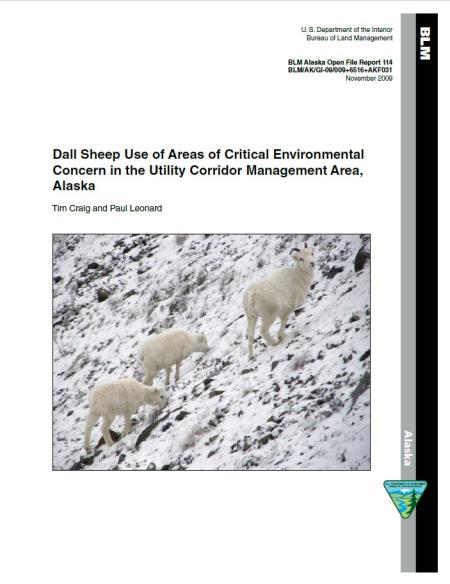Dall Sheep Use of Areas of Critical Environmental Concern in the Utility Corridor Management Unit, Alaska

From summer 2000 through summer 2006, we sporadically searched for Dall sheep (Ovis dalli) and/or evidence of their habitat use in 5 Areas of Critical Environmental Concern (ACECs) on Bureau of Land Management-administered lands in the eastern Brooks Range of northern Alaska. The purpose of our work was to determine (1) when sheep use the ACECs, (2) how many sheep use the ACECs, and (3) which areas within the ACECs were of special importance to sheep.
We found that sheep used all 5 ACECs year-round. We determined that lambing takes place in, or very near, all of the ACECs, and that ewes selected habitat near escape terrain and foraging areas to lamb. In each ACEC, sheep occupied locations with shallow snow, such as windswept ridges or south-facing, steep slopes during the winter. We were not able to accurately estimate the sheep population in the ACECs during this season because of the difficulty in detecting white sheep in the snow. However, the number of tracks we found suggested that far fewer sheep occupy the ACECs in the winter than in the summer.
The highest number of sheep we observed during the summer on any one survey was in the Snowden Mountain ACEC (N = 173), and the lowest numbers were in the Galbraith Lake and West Fork Atigun ACECs (N = 6 and 8, respectively). Generally, we found sheep at high elevations during the summer and in selected habitat where vegetation was low and sparse, such as the earth cover classes Low Shrub, Low Shrub – Lichen, Dwarf Shrub, Dwarf Shrub – Lichen, and Rock/Gravel. The relative density of tracks during the winter indicated that the Snowden Mountain and Poss Mountain ACECs hosted the greatest number of sheep during these months, while the West Fork Atigun and Nugget Creek ACECs held the least.
Sheep were observed 1212 times in the ACECs during our surveys, but we made many more observations of sheep immediately outside ACEC boundaries. In addition, we located previously unreported potential sheep licks in the Snowden Mountain and the West Fork Atigun ACECs.
Our results indicate that the sheep population within the ACECs may fluctuate annually without known causation, a phenomenon that is reflected in surveys of the greater sheep population elsewhere in the Brooks Range. The population structure in the ACECs is within the ranges of both historic and contemporary values determined for sheep elsewhere in the Brooks Range. The data collected during our work can be used for future population comparisons and as a baseline for sheep habitat use within the ACECs.
